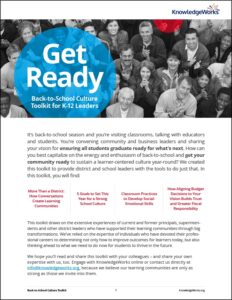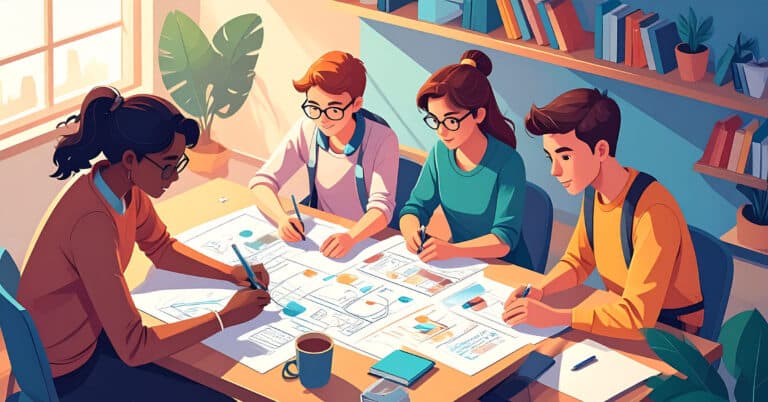
Take advantage of this new school year, while everything from school supplies to students’ smiling faces is shining and new, to set classroom goals that will help you and your students co-create a strong classroom culture. Here are five goals you might consider for your classroom:
1. Empower students as leaders and decision makers
Key to personalized learning is the idea that students own their own learning; it’s the difference between a teacher-centered classroom and a student-centered classroom. When students own their own learning, they are empowered to make decisions about how to demonstrate mastery, when and how to ask for assistance and to explore topics that are interesting to them.
As you work with students over the course of this year, ask the question: “How will you encourage and empower each one to own his or her own learning?” Marina Hopkins recommends using “How might we…” questions to further this type of exploration, such as:
- How might we amplify student voice in the classroom?
- How might we make learning interactive and experiential over the course of this school year?
- How might we encourage stronger teacher/student relationships?
2. Celebrate student growth
Learning opportunities come both from successes and failures, particularly when we take the time to reflect on what has and hasn’t worked and how that effects our actions moving forward. How will you take the time this school year to celebrate student growth? Here are some ideas you can borrow from:
- At Northwood Elementary in Marysville, Ohio, students wear brag tags to celebrate growth in academics and behavior. Students are recognized by teachers as well as peers, promoting a culture of collegiality.
- At Henry Cottrell Elementary in Monmouth, Maine, students celebrate their growth with balloons. As students progress toward mastery, their balloons get bigger; all students have balloons and feel pride as their balloons grow!
- At Waukesha STEM Academy in Waukesha, Wisconsin, students share their growth at STEM Student Showcases. Students share what they are passionate about via their STEMfolios, or digital portfolios.

Back-to-School Culture Toolkit
3. Model a growth mindset and foster the same in your students
When Abbie Forbus sat down with State Teachers of the Year to talk about personalized learning, there was consensus that teachers wanted to see more students becoming lifelong learners. They saw teaching growth mindset alongside the academic curriculum as essential to helping students graduate college and career ready. One way to teach growth mindset is to model the behavior for your students!
“A growth mindset is so important because it means our intelligence isn’t fixed,” said Robin Kanaan. “Our intelligence can be grown or developed with persistence, effort and a focus on learning.”
We have an obligation to gift each one of our students with the chance to become better. When we can foster an environment where everyone has a growth mindset, it leaves us open to struggle, trial and failure, but also triumph.
Students often don't know that effective learners reflect on the strategies they use https://t.co/WCt8e68BV0 #edchat #growthmindset
— MindShift (@MindShiftKQED) July 16, 2017
4. Partner with students to apply the district vision to your classroom
“Vision isn’t something you put up on a plaque,” said RSU2 Superintendent Bill Zima during a conversation with Jesse Moyer. “It really needs to be revisited and thought about and talked about. Is what we’re doing aligned to our vision? If not, do we need to readjust the how or why to make sure everything is aligned?”
If a district vision is strong, it can be applied at every level of teaching and learning within the district, particularly within the classroom. Work with your students to look at the vision and apply it to the work you are doing.
A #schooldistrict's shared #vision informs the system culture https://t.co/VlfMnuJQ4J @knowledgeworks #personalizedlearning #edpolicy
— Learning Community (@EdPersonalized) July 1, 2017
5. Create a culture of transparency within your classroom
We often talk about transparency as being essential to personalized learning because it allows members of the learning community to be informed about what’s happening and play an active role in creating the desired culture. Students are an essential part of the learning community, so how can you promote transparency in your classroom?
At the Early Childhood Center of Kenowa Hills, where students range from ages two to five, staff have focused on increasing transparency with both students and parents throughout this school year using data walls.
“Hallways have been transformed into a public data wall to correspond with each learning standard,” said Laura Hilger. “When students demonstrate the standard, they post their accomplishment – in the form of a key to ‘unlock their future’ – for all to see.”
Using #DataWalls to Increase Transparency in #CompetencyBasedEducation: https://t.co/CeX8Bpc7zD @KenowaHills @HilgerL #CompEd #CBE
— Abbie Forbus (@Aforbus) June 26, 2017
For Angela Patterson, a teacher in the Elmbrook School District, transparency has helped transform relationships between students and teachers. “Transparency has helped to solidify the commitment to student-first environments,” she said. “It ensures that each child in our school is truly “our student,” not just mine, yours or theirs.”



